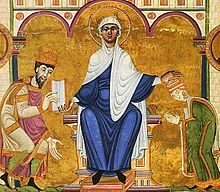Agnes of Poitou
| Agnes of Poitou | |
|---|---|

Henry III and Agnes at Mary's throne, Speyer Evangeliary, 1046
|
|
| Empress consort of the Holy Roman Empire | |
| Reign | 1046–1056 |
| Coronation | 25 December 1046 |
| Queen consort of Germany | |
| Reign | 1043–1056 |
| Born | c. 1025 |
| Died | 14 December 1077 Rome |
| Spouse | Henry III, Holy Roman Emperor |
| Issue more... |
Adelaide II, Abbess of Quedlinburg Henry IV, Holy Roman Emperor Conrad II, Duke of Bavaria Judith of Swabia |
| House | House of Poitiers (Ramnulfids) |
| Father | William V, Duke of Aquitaine |
| Mother | Agnes of Burgundy |
Agnes of Poitou, also called Agnes of Aquitaine or Empress Agnes (c. 1025 – 14 December 1077), a member of the House of Poitiers, was German queen from 1043 and Holy Roman Empress from 1046 until 1056. From 1056 to 1061 she acted as regent of the Holy Roman Empire during the minority of her son Henry IV.
She was the daughter of the Ramnulfid duke William V of Aquitaine (d. 1030) and Agnes of Burgundy. She thereby was the sister of Duke William VI of Aquitaine, Duke Odo of Gascony, Duke William VII, and Duke William VIII of Aquitaine. Her maternal grandparents were Count Otto-William of Burgundy and Ermentrude of Rheims, daughter of Renaud of Roucy.
Agnes married King Henry III of Germany in November 1043 at the Imperial Palace Ingelheim. She was his second wife after Gunhilda of Denmark, who had died from malaria in 1038. This marriage helped to solidify the Empire's relationships with the princely houses in the west. King Henry was able to improve his position versus the French royal dynasty and to exert his influence in the Duchy of Burgundy. Agnes, like her husband, was of profound piety, her family had founded Cluny Abbey and Abbot Hugh the Great was godfather of her son Henry IV.
...
Wikipedia
